Romanian vs Iraqi Community Comparison
COMPARE
Romanian
Iraqi
Social Comparison
Social Comparison
Romanians
Iraqis
9,022
SOCIAL INDEX
87.7/ 100
SOCIAL RATING
35th/ 347
SOCIAL RANK
5,167
SOCIAL INDEX
49.2/ 100
SOCIAL RATING
183rd/ 347
SOCIAL RANK
Iraqi Integration in Romanian Communities
The statistical analysis conducted on geographies consisting of 155,379,024 people shows a mild positive correlation between the proportion of Iraqis within Romanian communities in the United States with a correlation coefficient (R) of 0.387. On average, for every 1% (one percent) increase in Romanians within a typical geography, there is an increase of 0.181% in Iraqis. To illustrate, in a geography comprising of 100,000 individuals, a rise of 1,000 Romanians corresponds to an increase of 181.4 Iraqis.
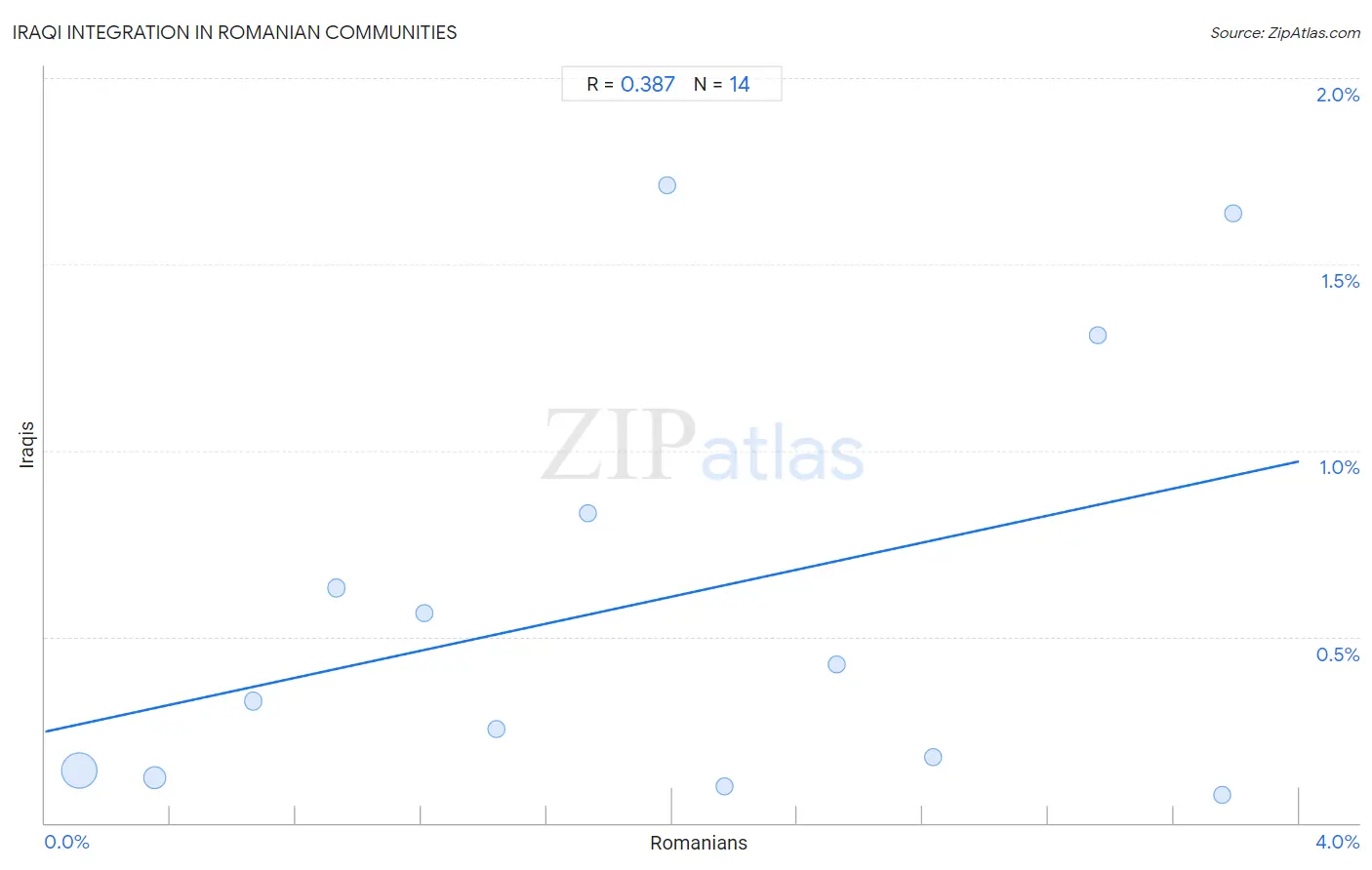
Romanian vs Iraqi Income
When considering income, the most significant differences between Romanian and Iraqi communities in the United States are seen in per capita income ($48,445 compared to $42,760, a difference of 13.3%), householder income ages 25 - 44 years ($102,544 compared to $90,764, a difference of 13.0%), and median male earnings ($60,063 compared to $54,182, a difference of 10.8%). Conversely, both communities are more comparable in terms of wage/income gap (28.0% compared to 26.6%, a difference of 5.0%), householder income under 25 years ($53,632 compared to $50,802, a difference of 5.6%), and householder income over 65 years ($64,142 compared to $60,466, a difference of 6.1%).

| Income Metric | Romanian | Iraqi |
| Per Capita Income | Exceptional $48,445 | Fair $42,760 |
| Median Family Income | Exceptional $111,243 | Fair $100,658 |
| Median Household Income | Exceptional $91,994 | Fair $83,753 |
| Median Earnings | Exceptional $50,244 | Fair $46,140 |
| Median Male Earnings | Exceptional $60,063 | Average $54,182 |
| Median Female Earnings | Exceptional $41,663 | Poor $38,666 |
| Householder Age | Under 25 years | Exceptional $53,632 | Tragic $50,802 |
| Householder Age | 25 - 44 years | Exceptional $102,544 | Poor $90,764 |
| Householder Age | 45 - 64 years | Exceptional $108,609 | Fair $99,387 |
| Householder Age | Over 65 years | Exceptional $64,142 | Fair $60,466 |
| Wage/Income Gap | Tragic 28.0% | Poor 26.6% |
Romanian vs Iraqi Poverty
When considering poverty, the most significant differences between Romanian and Iraqi communities in the United States are seen in married-couple family poverty (4.8% compared to 5.9%, a difference of 21.2%), child poverty under the age of 16 (14.8% compared to 17.5%, a difference of 18.8%), and child poverty among boys under 16 (15.0% compared to 17.7%, a difference of 18.1%). Conversely, both communities are more comparable in terms of seniors poverty over the age of 75 (11.6% compared to 11.7%, a difference of 1.4%), single male poverty (12.5% compared to 12.3%, a difference of 1.5%), and female poverty among 25-34 year olds (12.8% compared to 13.2%, a difference of 3.1%).
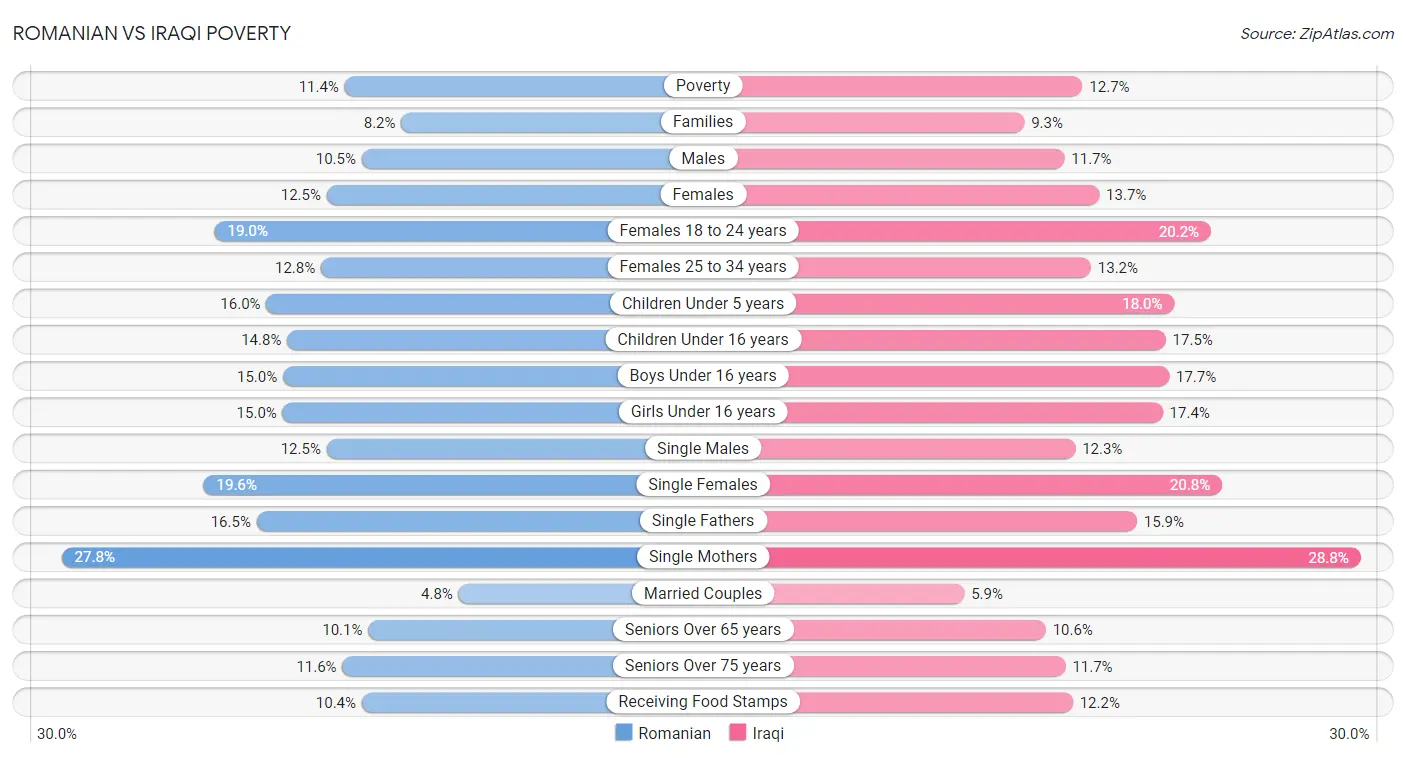
| Poverty Metric | Romanian | Iraqi |
| Poverty | Exceptional 11.4% | Fair 12.7% |
| Families | Exceptional 8.2% | Fair 9.3% |
| Males | Exceptional 10.5% | Poor 11.7% |
| Females | Exceptional 12.5% | Fair 13.7% |
| Females 18 to 24 years | Exceptional 19.0% | Average 20.2% |
| Females 25 to 34 years | Exceptional 12.8% | Good 13.2% |
| Children Under 5 years | Exceptional 16.0% | Poor 18.0% |
| Children Under 16 years | Exceptional 14.8% | Tragic 17.5% |
| Boys Under 16 years | Exceptional 15.0% | Tragic 17.7% |
| Girls Under 16 years | Exceptional 15.0% | Poor 17.4% |
| Single Males | Excellent 12.5% | Exceptional 12.3% |
| Single Females | Exceptional 19.6% | Good 20.8% |
| Single Fathers | Fair 16.5% | Exceptional 15.9% |
| Single Mothers | Exceptional 27.8% | Good 28.8% |
| Married Couples | Exceptional 4.8% | Tragic 5.9% |
| Seniors Over 65 years | Exceptional 10.1% | Excellent 10.6% |
| Seniors Over 75 years | Exceptional 11.6% | Excellent 11.7% |
| Receiving Food Stamps | Exceptional 10.4% | Fair 12.2% |
Romanian vs Iraqi Unemployment
When considering unemployment, the most significant differences between Romanian and Iraqi communities in the United States are seen in unemployment among seniors over 75 years (9.0% compared to 9.9%, a difference of 10.6%), female unemployment (5.0% compared to 5.5%, a difference of 9.0%), and unemployment among ages 45 to 54 years (4.4% compared to 4.7%, a difference of 7.7%). Conversely, both communities are more comparable in terms of unemployment among youth under 25 years (11.4% compared to 11.5%, a difference of 0.65%), unemployment among ages 20 to 24 years (10.2% compared to 10.3%, a difference of 1.3%), and unemployment among ages 55 to 59 years (4.7% compared to 4.7%, a difference of 1.7%).
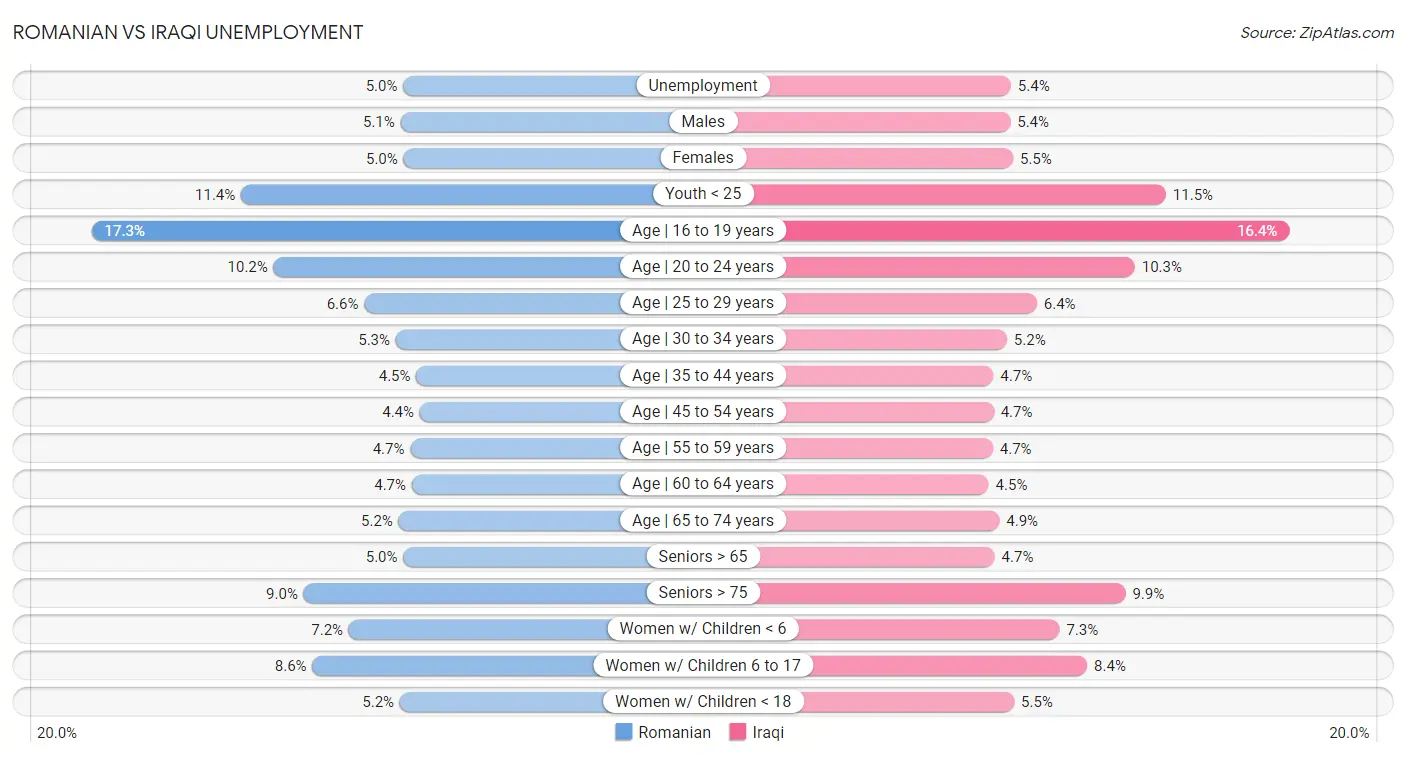
| Unemployment Metric | Romanian | Iraqi |
| Unemployment | Exceptional 5.0% | Poor 5.4% |
| Males | Excellent 5.1% | Fair 5.4% |
| Females | Exceptional 5.0% | Tragic 5.5% |
| Youth < 25 | Excellent 11.4% | Good 11.5% |
| Age | 16 to 19 years | Good 17.3% | Exceptional 16.4% |
| Age | 20 to 24 years | Excellent 10.2% | Average 10.3% |
| Age | 25 to 29 years | Good 6.6% | Exceptional 6.4% |
| Age | 30 to 34 years | Excellent 5.3% | Exceptional 5.2% |
| Age | 35 to 44 years | Exceptional 4.5% | Average 4.7% |
| Age | 45 to 54 years | Exceptional 4.4% | Tragic 4.7% |
| Age | 55 to 59 years | Excellent 4.7% | Exceptional 4.7% |
| Age | 60 to 64 years | Exceptional 4.7% | Exceptional 4.5% |
| Age | 65 to 74 years | Exceptional 5.2% | Exceptional 4.9% |
| Seniors > 65 | Exceptional 5.0% | Exceptional 4.7% |
| Seniors > 75 | Poor 9.0% | Tragic 9.9% |
| Women w/ Children < 6 | Exceptional 7.2% | Exceptional 7.3% |
| Women w/ Children 6 to 17 | Exceptional 8.6% | Exceptional 8.4% |
| Women w/ Children < 18 | Exceptional 5.2% | Fair 5.5% |
Romanian vs Iraqi Labor Participation
When considering labor participation, the most significant differences between Romanian and Iraqi communities in the United States are seen in in labor force | age 16-19 (37.5% compared to 38.6%, a difference of 3.1%), in labor force | age 30-34 (84.8% compared to 83.8%, a difference of 1.2%), and in labor force | age 25-29 (84.8% compared to 83.9%, a difference of 1.1%). Conversely, both communities are more comparable in terms of in labor force | age 20-64 (79.8% compared to 79.3%, a difference of 0.56%), in labor force | age 20-24 (75.5% compared to 76.0%, a difference of 0.62%), and in labor force | age 35-44 (84.5% compared to 83.8%, a difference of 0.86%).

| Labor Participation Metric | Romanian | Iraqi |
| In Labor Force | Age > 16 | Fair 65.0% | Exceptional 65.7% |
| In Labor Force | Age 20-64 | Good 79.8% | Poor 79.3% |
| In Labor Force | Age 16-19 | Excellent 37.5% | Exceptional 38.6% |
| In Labor Force | Age 20-24 | Excellent 75.5% | Exceptional 76.0% |
| In Labor Force | Age 25-29 | Good 84.8% | Tragic 83.9% |
| In Labor Force | Age 30-34 | Good 84.8% | Tragic 83.8% |
| In Labor Force | Age 35-44 | Good 84.5% | Tragic 83.8% |
| In Labor Force | Age 45-54 | Good 83.0% | Tragic 82.2% |
Romanian vs Iraqi Family Structure
When considering family structure, the most significant differences between Romanian and Iraqi communities in the United States are seen in single mother households (5.6% compared to 6.1%, a difference of 9.1%), births to unmarried women (28.7% compared to 27.6%, a difference of 4.3%), and married-couple households (48.4% compared to 46.9%, a difference of 3.4%). Conversely, both communities are more comparable in terms of divorced or separated (11.8% compared to 11.8%, a difference of 0.010%), family households (64.5% compared to 64.4%, a difference of 0.29%), and average family size (3.18 compared to 3.24, a difference of 1.8%).

| Family Structure Metric | Romanian | Iraqi |
| Family Households | Good 64.5% | Average 64.4% |
| Family Households with Children | Good 27.6% | Exceptional 28.5% |
| Married-couple Households | Exceptional 48.4% | Good 46.9% |
| Average Family Size | Tragic 3.18 | Good 3.24 |
| Single Father Households | Exceptional 2.1% | Exceptional 2.2% |
| Single Mother Households | Exceptional 5.6% | Good 6.1% |
| Currently Married | Exceptional 48.4% | Good 46.9% |
| Divorced or Separated | Exceptional 11.8% | Exceptional 11.8% |
| Births to Unmarried Women | Exceptional 28.7% | Exceptional 27.6% |
Romanian vs Iraqi Vehicle Availability
When considering vehicle availability, the most significant differences between Romanian and Iraqi communities in the United States are seen in no vehicles in household (10.9% compared to 7.7%, a difference of 41.2%), 1 or more vehicles in household (89.2% compared to 91.9%, a difference of 3.1%), and 2 or more vehicles in household (55.5% compared to 57.1%, a difference of 2.9%). Conversely, both communities are more comparable in terms of 4 or more vehicles in household (6.2% compared to 6.2%, a difference of 0.77%), 3 or more vehicles in household (19.3% compared to 19.6%, a difference of 1.5%), and 2 or more vehicles in household (55.5% compared to 57.1%, a difference of 2.9%).

| Vehicle Availability Metric | Romanian | Iraqi |
| No Vehicles Available | Poor 10.9% | Exceptional 7.7% |
| 1+ Vehicles Available | Poor 89.2% | Exceptional 91.9% |
| 2+ Vehicles Available | Average 55.5% | Exceptional 57.1% |
| 3+ Vehicles Available | Fair 19.3% | Average 19.6% |
| 4+ Vehicles Available | Fair 6.2% | Fair 6.2% |
Romanian vs Iraqi Education Level
When considering education level, the most significant differences between Romanian and Iraqi communities in the United States are seen in no schooling completed (1.8% compared to 2.4%, a difference of 32.4%), professional degree (5.3% compared to 4.5%, a difference of 16.3%), and doctorate degree (2.1% compared to 1.8%, a difference of 14.6%). Conversely, both communities are more comparable in terms of nursery school (98.3% compared to 97.7%, a difference of 0.54%), kindergarten (98.2% compared to 97.7%, a difference of 0.54%), and 1st grade (98.2% compared to 97.7%, a difference of 0.54%).
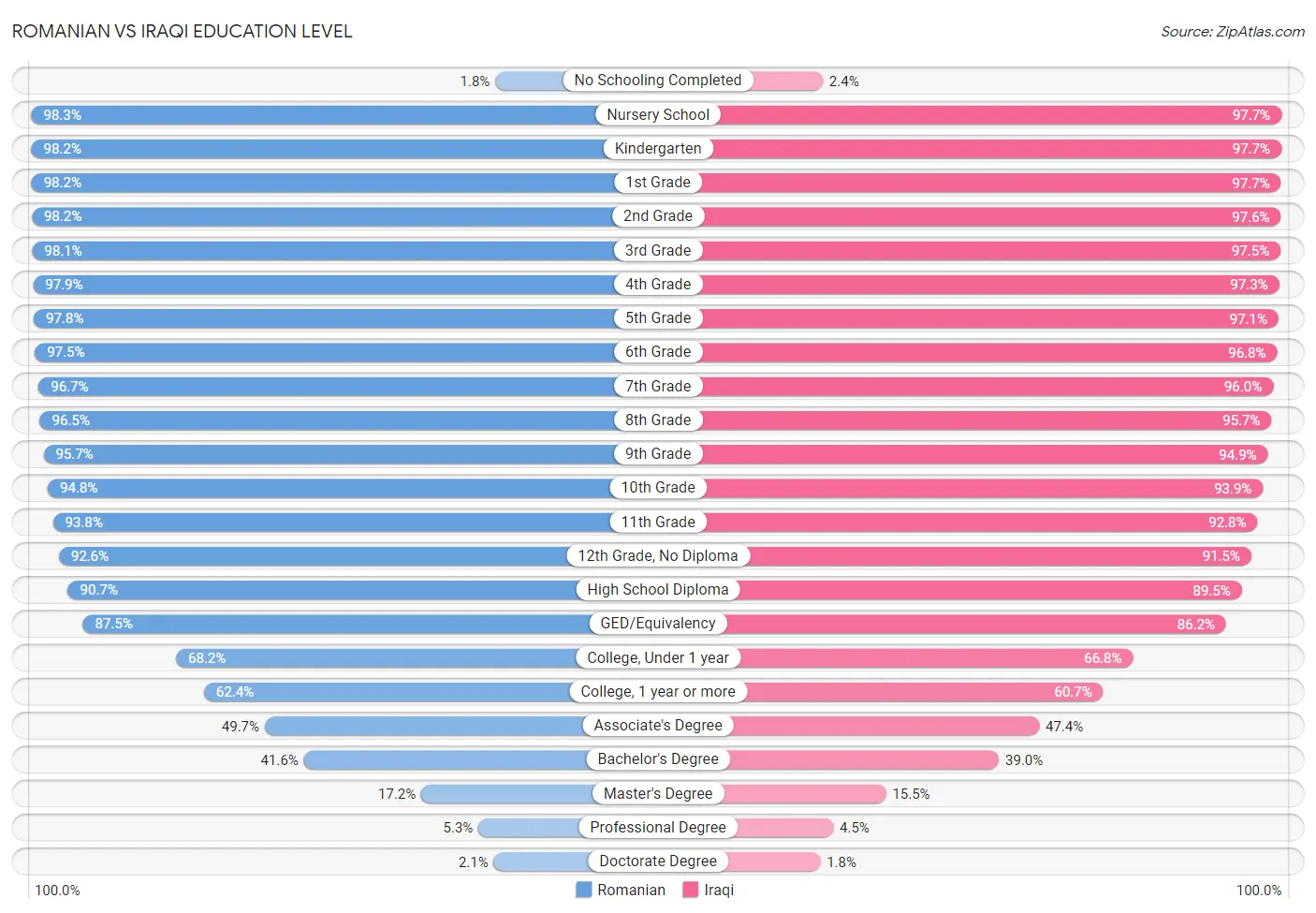
| Education Level Metric | Romanian | Iraqi |
| No Schooling Completed | Exceptional 1.8% | Tragic 2.4% |
| Nursery School | Exceptional 98.3% | Tragic 97.7% |
| Kindergarten | Exceptional 98.2% | Tragic 97.7% |
| 1st Grade | Exceptional 98.2% | Tragic 97.7% |
| 2nd Grade | Exceptional 98.2% | Tragic 97.6% |
| 3rd Grade | Exceptional 98.1% | Tragic 97.5% |
| 4th Grade | Exceptional 97.9% | Tragic 97.3% |
| 5th Grade | Exceptional 97.8% | Poor 97.1% |
| 6th Grade | Exceptional 97.5% | Poor 96.8% |
| 7th Grade | Exceptional 96.7% | Average 96.0% |
| 8th Grade | Exceptional 96.5% | Average 95.7% |
| 9th Grade | Exceptional 95.7% | Average 94.9% |
| 10th Grade | Exceptional 94.8% | Good 93.9% |
| 11th Grade | Exceptional 93.8% | Good 92.8% |
| 12th Grade, No Diploma | Exceptional 92.6% | Good 91.5% |
| High School Diploma | Exceptional 90.7% | Good 89.5% |
| GED/Equivalency | Exceptional 87.5% | Good 86.2% |
| College, Under 1 year | Exceptional 68.2% | Excellent 66.8% |
| College, 1 year or more | Exceptional 62.4% | Excellent 60.7% |
| Associate's Degree | Exceptional 49.7% | Good 47.4% |
| Bachelor's Degree | Exceptional 41.6% | Good 39.0% |
| Master's Degree | Exceptional 17.2% | Good 15.5% |
| Professional Degree | Exceptional 5.3% | Good 4.5% |
| Doctorate Degree | Exceptional 2.1% | Average 1.8% |
Romanian vs Iraqi Disability
When considering disability, the most significant differences between Romanian and Iraqi communities in the United States are seen in disability age under 5 (1.3% compared to 1.2%, a difference of 10.2%), disability age 65 to 74 (22.1% compared to 24.2%, a difference of 9.5%), and disability age 35 to 64 (10.6% compared to 11.5%, a difference of 8.7%). Conversely, both communities are more comparable in terms of disability age 18 to 34 (6.6% compared to 6.7%, a difference of 0.16%), male disability (11.2% compared to 11.3%, a difference of 1.2%), and hearing disability (3.1% compared to 3.1%, a difference of 1.2%).
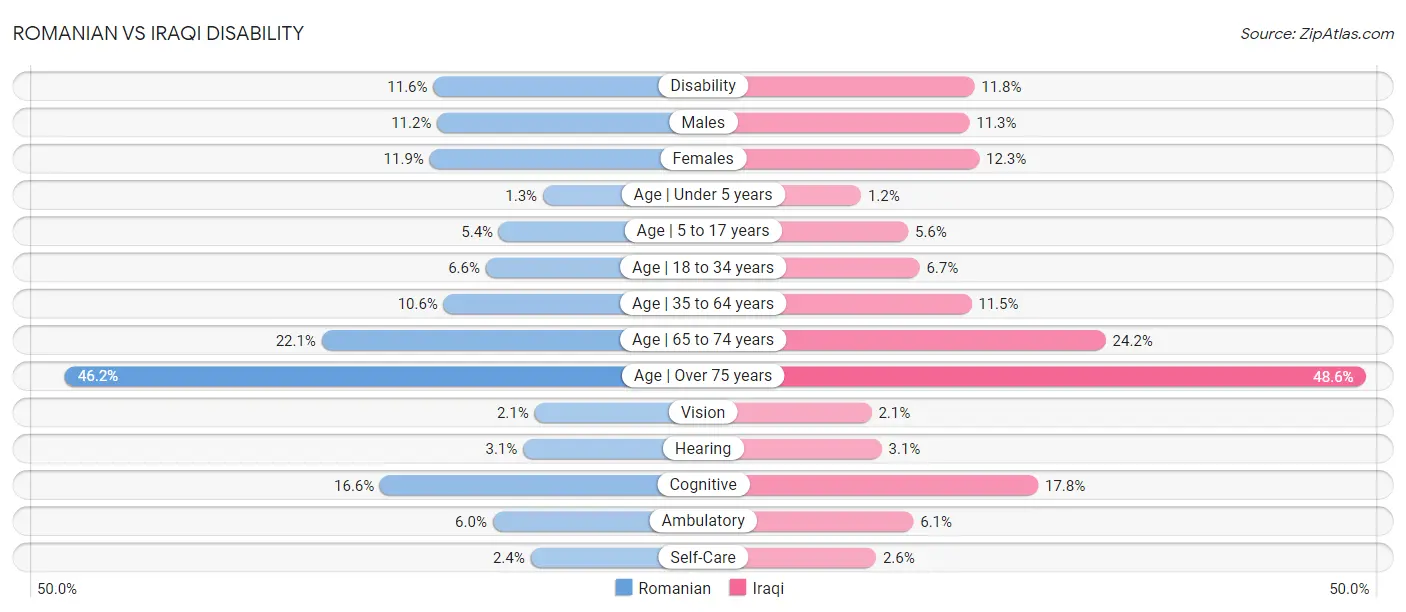
| Disability Metric | Romanian | Iraqi |
| Disability | Good 11.6% | Fair 11.8% |
| Males | Average 11.2% | Fair 11.3% |
| Females | Exceptional 11.9% | Fair 12.3% |
| Age | Under 5 years | Fair 1.3% | Exceptional 1.2% |
| Age | 5 to 17 years | Exceptional 5.4% | Average 5.6% |
| Age | 18 to 34 years | Fair 6.6% | Fair 6.7% |
| Age | 35 to 64 years | Exceptional 10.6% | Fair 11.5% |
| Age | 65 to 74 years | Exceptional 22.1% | Tragic 24.2% |
| Age | Over 75 years | Exceptional 46.2% | Tragic 48.6% |
| Vision | Exceptional 2.1% | Good 2.1% |
| Hearing | Poor 3.1% | Poor 3.1% |
| Cognitive | Exceptional 16.6% | Tragic 17.8% |
| Ambulatory | Excellent 6.0% | Good 6.1% |
| Self-Care | Good 2.4% | Tragic 2.6% |